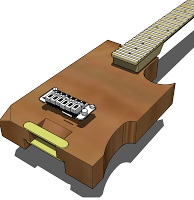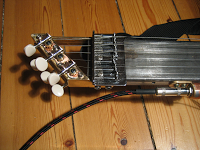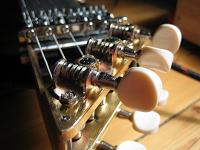Guitar
 In the previous post, I described my intention of creating a playable testbed for experiments with different pickups. It turned out to be nice to play, so I improved it with a strap horn and the acrylic body from my t-beam bass. As it turned out, it was quite neck heavy. And since I prefer a headless guitar in most circumstances, I began to consider a tuner system down behind the bridge plus removing the headstock.
In the previous post, I described my intention of creating a playable testbed for experiments with different pickups. It turned out to be nice to play, so I improved it with a strap horn and the acrylic body from my t-beam bass. As it turned out, it was quite neck heavy. And since I prefer a headless guitar in most circumstances, I began to consider a tuner system down behind the bridge plus removing the headstock.
The design - as many others - uses traditional tuners mounted at the end of the guitar. Most of the existing designs however, has the strings fan out from the bridge and onto the tuners. The tuners have a lot of distance between them in order to allow room for the fingers when tuning. One solution is a design using two rows of three tunes facing each other and sharing the same slot. For the latter, I bought a set of six twelve-string tuners (they have the pegs closer together than six string tuners, saving space).
 I built a bracket for mounting them on the end of the testbed guitar. It is soldered together from rectangular brass profiles. The profiles carrying the tuners are at an angle so that there's a (reasonably) straight string pull.
I built a bracket for mounting them on the end of the testbed guitar. It is soldered together from rectangular brass profiles. The profiles carrying the tuners are at an angle so that there's a (reasonably) straight string pull.
The tuners are made from one side of the twelve string tuners, cut in half - i.e. 2 x 3 tuners. I found out that they had a nice copper coating beneath the crome, so I filed away some of the chrome. I hope, when the steel and copper oxidizes, that they will look more discreet. They seem to work decently, but I imagine that better quality tuners might improve the system somewhat.
The strings can be tuned easily and precisely. Mounting the strings is a bit troublesome, but will probably be easier when I've tried it a couple of times. Unfortunately, my soldering job was insufficient and the top plate broke off. When I re-soldered it (and bolted it too, to be on the safe side), I was too hasty, and the holes for the pegs didn't line up. I had to do a bit of filing, and now the arrangement works, but less smoothly than the first time. I'm not completely satisfied, so I will buy a machine vise for my drill press and make a better bracket. That will give me a chance also to try some better tuners. They could be these due to their good looks (though it might look too _deliberately aged_ for my taste) or these due to their high gear ratio
had to do a bit of filing, and now the arrangement works, but less smoothly than the first time. I'm not completely satisfied, so I will buy a machine vise for my drill press and make a better bracket. That will give me a chance also to try some better tuners. They could be these due to their good looks (though it might look too _deliberately aged_ for my taste) or these due to their high gear ratio
If they keep working well, I'll cut the headstock off the neck, but for now I am anchoring the ball end of the strings in the existing tuner pegs on the headstock. I plan to play it for some time and make sure that it's a keeper (the overall design, not this particular version). I've got to be certain this works before chopping away.
- Truly Headless
After postponing it a number of times, I cut off the strat headstock of my very fine Warmoth neck. That took a bit of self persuation, but I needed it headless. A brass angle bracket is holding the strings. I also made a new acrylic body. This time, I...
- The Developing Guitar
I have begun preparing a testbed for my experiments. I want something that's playable. It should be a proper guitar. But it should also be a proper testbed for new pickups, forearm support, strap horn and leg rest. It's built from a warmoth strat...
- Coarse Tuners Part 2
As described in an earlier post, I've tried to make a compact set of coarse tuners to go with the fine tuners on my Schaller 456 fine tuning bridge, so I could reduce the headstock and loose the big and heavy traditional tuners. The earlier attempt...
- New Tuners
I've always wanted to try out my a particular form of tuners for headless guitars and basses. They work by having a scew pulling a brass block in which the ball end of the string is mounted. The main inspiration was Jeff Turpin's tuners; drawings...
- Bridge And Tuners For The Headless Design
Having settled on a headless design, one of the next questions was which bridge and tuners to use. A small number of bridges with built-in tuners already exist, e.g. the ABM or the Steinberger. Unfortunately, they are all fairly expensive, and it was...
Guitar
New tuner design
 In the previous post, I described my intention of creating a playable testbed for experiments with different pickups. It turned out to be nice to play, so I improved it with a strap horn and the acrylic body from my t-beam bass. As it turned out, it was quite neck heavy. And since I prefer a headless guitar in most circumstances, I began to consider a tuner system down behind the bridge plus removing the headstock.
In the previous post, I described my intention of creating a playable testbed for experiments with different pickups. It turned out to be nice to play, so I improved it with a strap horn and the acrylic body from my t-beam bass. As it turned out, it was quite neck heavy. And since I prefer a headless guitar in most circumstances, I began to consider a tuner system down behind the bridge plus removing the headstock.The design - as many others - uses traditional tuners mounted at the end of the guitar. Most of the existing designs however, has the strings fan out from the bridge and onto the tuners. The tuners have a lot of distance between them in order to allow room for the fingers when tuning. One solution is a design using two rows of three tunes facing each other and sharing the same slot. For the latter, I bought a set of six twelve-string tuners (they have the pegs closer together than six string tuners, saving space).
The tuners are made from one side of the twelve string tuners, cut in half - i.e. 2 x 3 tuners. I found out that they had a nice copper coating beneath the crome, so I filed away some of the chrome. I hope, when the steel and copper oxidizes, that they will look more discreet. They seem to work decently, but I imagine that better quality tuners might improve the system somewhat.
The strings can be tuned easily and precisely. Mounting the strings is a bit troublesome, but will probably be easier when I've tried it a couple of times. Unfortunately, my soldering job was insufficient and the top plate broke off. When I re-soldered it (and bolted it too, to be on the safe side), I was too hasty, and the holes for the pegs didn't line up. I
If they keep working well, I'll cut the headstock off the neck, but for now I am anchoring the ball end of the strings in the existing tuner pegs on the headstock. I plan to play it for some time and make sure that it's a keeper (the overall design, not this particular version). I've got to be certain this works before chopping away.
- Truly Headless
After postponing it a number of times, I cut off the strat headstock of my very fine Warmoth neck. That took a bit of self persuation, but I needed it headless. A brass angle bracket is holding the strings. I also made a new acrylic body. This time, I...
- The Developing Guitar
I have begun preparing a testbed for my experiments. I want something that's playable. It should be a proper guitar. But it should also be a proper testbed for new pickups, forearm support, strap horn and leg rest. It's built from a warmoth strat...
- Coarse Tuners Part 2
As described in an earlier post, I've tried to make a compact set of coarse tuners to go with the fine tuners on my Schaller 456 fine tuning bridge, so I could reduce the headstock and loose the big and heavy traditional tuners. The earlier attempt...
- New Tuners
I've always wanted to try out my a particular form of tuners for headless guitars and basses. They work by having a scew pulling a brass block in which the ball end of the string is mounted. The main inspiration was Jeff Turpin's tuners; drawings...
- Bridge And Tuners For The Headless Design
Having settled on a headless design, one of the next questions was which bridge and tuners to use. A small number of bridges with built-in tuners already exist, e.g. the ABM or the Steinberger. Unfortunately, they are all fairly expensive, and it was...
